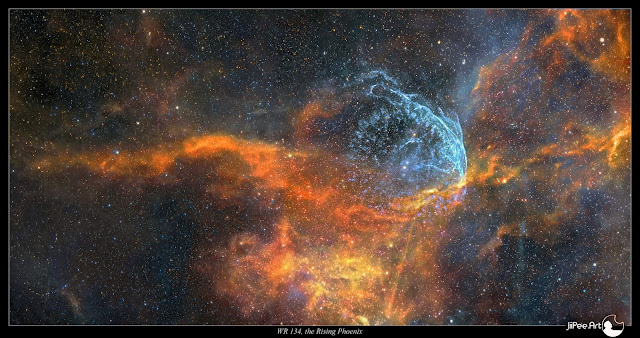COPYRIGHT, PLEASE NOTE
Tuesday, October 15, 2024
WR 134, The Rising Phoenix
BUY A POSTER
https://astroanarchy.zenfolio.com/
This is the second light for my new imaging setup, the first light image can be seen HERE
For years I have wanted to shoot a long focal length photo of this amazing mass ejecting star in constellation Cygnus, the Swan. Past five years I have done short focal length imaging with camera optics, now it's time to get closer.
I spent several clear nights to capture light emitted by an ionized elements in this gas formation. (H-alpha, S-II and O-III) For compositional reasons I ended up to a two panel mosaic image. Total exposure time is 23h.
When processing the final image I couldn't be noticing how much this formation looked like a mystical creature, the Phoenix Bird. I rarely use any other than official catalog numbers as a name of my photos but this time I simply had to name this composition to "Rising Phoenix".
When art meets science, the results can be beautiful. It can become something more than either of them on their own can ever be.
WR 134 as a Rising Phoenix
Click for a large image, 2500x1300 pixels photo shows the WR 134 like never seen before.
 The photo is in mapped colors from an ionized elements, H-alpha=green, S-II=red and O-III=blue, Original resolution is 12.000 x 7000 pixels
The photo is in mapped colors from an ionized elements, H-alpha=green, S-II=red and O-III=blue, Original resolution is 12.000 x 7000 pixelsInfo about the WR 134
WR 134 is a variable Wolf-Rayet star located around 6,000 light years away from us in the constellation of Cygnus. It's surrounded by a faint bubble of glowing ionized oxygen, blown out by the intense radiation and fast solar wind from the star. The star has five times the radius of the sun and it's 400,000 times more luminous.
My Wide Field Photo of the Area
Click for a large image, ~2500x2000 pixels
WR 134, the Rising Phoenix in visual spectrum
Click for a large image, ~2500x1300 pixels
Click for a large image
A single, full scale, 20 min O-III exposure
Click for a full scale image.
This is a dim target, 1200s O-III exposure doesn't show much about the O-III formation around the star WR 134.
 This is one of the test shots after the collimation procedure. Exposure time is 1200s with 3nm O-III filter. Image is calibrated with Dark Frame and Bias corrected Flat Frame. Target is WR 134 in Cygnus. Stars are pinpoint from corner to corner. Optical analysis of this frame can be found at end of THIS blogpost
This is one of the test shots after the collimation procedure. Exposure time is 1200s with 3nm O-III filter. Image is calibrated with Dark Frame and Bias corrected Flat Frame. Target is WR 134 in Cygnus. Stars are pinpoint from corner to corner. Optical analysis of this frame can be found at end of THIS blogpost
BUY A POSTER
https://astroanarchy.zenfolio.com/
















No comments:
Post a Comment